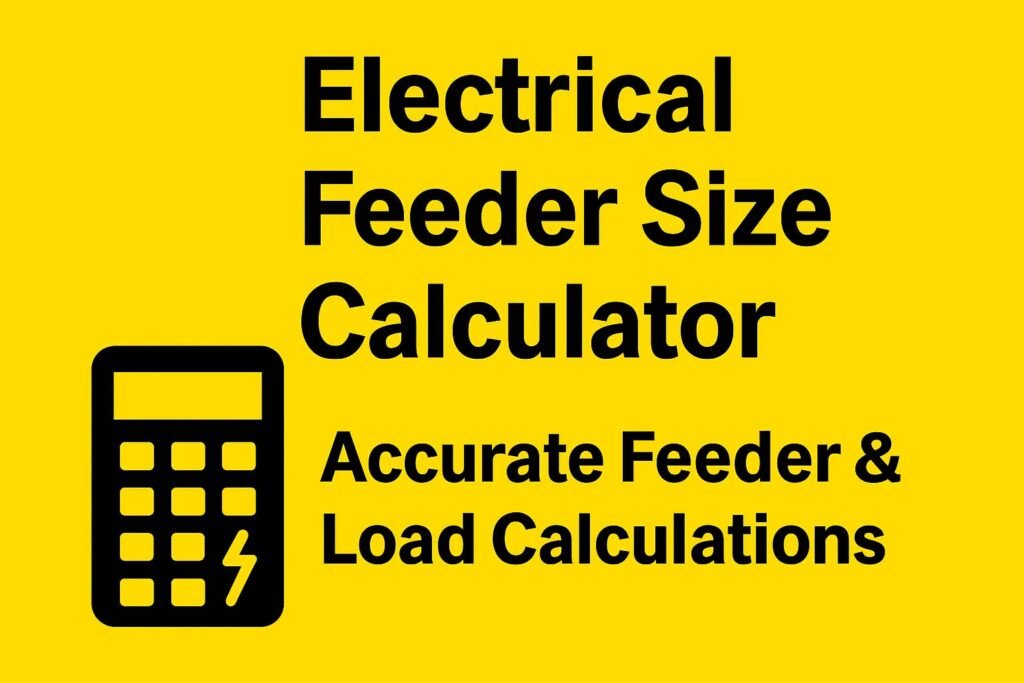Electrical Feeder Size Calculator: Best Tool for Accurate Feeder & Load Calculations
An electrical feeder size calculator helps you determine the correct feeder conductor size for any electrical system. It is used by electricians, engineers, and installers to choose the right cable that can safely carry current from the main service to subpanels or large equipment. Choosing the correct feeder size avoids voltage drop, overheating, and system failure. When you size a feeder correctly, your system becomes safer, more efficient, and compliant with electrical codes.

Table of Contents
Picking feeder conductors may look simple, but it takes several factors into account. An electrical feeder size calculator handles these variables automatically. It makes the sizing process faster and reduces human error. It also helps users understand how load, distance, and conductor material affect the overall design. Access our powerful online calculator now Electrical Diversity Calculator for accurate Load Estimation and efficient electrical Design.
How an Electrical Feeder Size Calculator Works
A feeder size calculator uses basic electrical formulas and NEC guidelines to suggest the proper wire size. It considers the load in amps, conductor material, voltage, ambient temperature, and the allowable voltage drop. These inputs help the tool calculate the minimum conductor that can safely handle current.
The calculator applies ampacity rules from standard tables and applies correction factors. It also adjusts the result when the distance is long. This prevents excessive voltage loss. Using a calculator is easier than manually checking multiple ampacity charts and correction tables.
Electrical Feeder Size Calculator
Electrical Feeder Size Calculator
Model design current, voltage drop sizing, and typical ampacity checks for copper or aluminum feeders.
| Size (mm²) | Copper approx. ampacity (A) | Aluminum approx. ampacity (A) |
|---|---|---|
| 10 | 55 | 40 |
| 16 | 75 | 55 |
| 25 | 95 | 75 |
| 35 | 125 | 95 |
| 50 | 150 | 120 |
| 70 | 200 | 155 |
| 95 | 240 | 190 |
| 120 | 285 | 220 |
| 150 | 325 | 255 |
| 185 | 370 | 290 |
| 240 | 435 | 340 |
– Enter system type, voltage, power factor, connected kW, diversity, and continuous load settings.
– Set feeder length, permissible voltage drop %, and choose copper or aluminum. Optionally add a resistivity increase (%) for hotter conditions.
– Click “Calculate” to see design current, minimum conductor area from voltage drop, an estimated voltage drop for standard sizes, and a suggested size with PASS/FAIL against your voltage drop target.
– Use the table to compare rough ampacity ranges; pick the next larger standard size that satisfies both voltage drop and ampacity per your local code.
This tool sizes primarily by voltage drop, then checks typical ampacity guidance. For final selection, apply your code’s ampacity, derating, and installation corrections (ambient, grouping, conduit/tray, insulation temperature class, etc.).
Key Inputs Used in Feeder Sizing
Below are the common inputs the calculator requires:
- Load current in amps
- Voltage (120V, 240V, 480V, etc.)
- Conductor material (copper or aluminum)
- Ambient temperature
- Distance in feet or meters
- Maximum allowed voltage drop
- Phase (single phase or three phase)
Each input affects the final conductor size. Copper and aluminum behave differently. Temperature changes the capacity of the wire. Long runs require larger conductors to overcome voltage loss. The calculator balances all these values. Make your task simple with our online tool electrical cable size calculator
Factors Affecting Feeder Conductor Size
Several conditions influence feeder conductor selection. The calculator simplifies these considerations, but it is helpful to understand what happens behind the scenes.
Load and Ampacity
The first step is determining the total connected load. This helps estimate the current the feeder must carry. Feeders must handle the load continuously without overheating. Ampacity depends on conductor size, insulation type, and temperature rating. Larger loads require conductors with higher ampacity.
Voltage Drop
Voltage drop happens when current flows across a long run of wire. If the voltage drop is too high, equipment may malfunction. A feeder size calculator helps select a conductor size that keeps the voltage drop within recommended limits. For long distances, the conductor size often increases. Explore our professional online tool for quick calculations kw to cable size calculator
Conductor Material
Copper has higher conductivity and smaller size compared to aluminum. Aluminum is more affordable but requires larger sizes to carry the same current. The calculator adjusts the results depending on which material you select.
Environmental Conditions
High ambient temperatures reduce the ampacity of wires. Multiple conductors bundled together also generate heat, requiring derating. A calculator applies these corrections automatically. Experience fast and accurate results using our online tool cable size calculator uk
Why an Electrical Feeder Size Calculator Is Useful
Using a feeder size calculator saves time and improves accuracy. It also ensures compliance with electrical standards. Manual calculations can be slow and prone to mistakes. A calculator avoids these issues and gives reliable results in seconds.
It also supports better planning. Engineers can test different scenarios instantly. For example, changing the conductor material or adjusting the distance allows users to see how it affects the feeder size. This makes the design process more flexible. Calculate instantly with our smart online tool cable size calculator australia
Example of Feeder Sizing Values
The table below shows example conductor sizes for typical load values. These are general estimates and may vary based on installation conditions.
| Load (Amps) | Copper Feeder Size | Aluminum Feeder Size | Typical Voltage |
|---|---|---|---|
| 60A | #6 AWG | #4 AWG | 240V |
| 100A | #3 AWG | #1 AWG | 240V |
| 150A | 1/0 AWG | 2/0 AWG | 240V |
| 200A | 2/0 AWG | 4/0 AWG | 240V |
| 300A | 350 kcmil | 500 kcmil | 240V/480V |
This table offers a quick comparison for planning. Actual installations must still consider voltage drop, temperature, insulation, and layout.
Steps to Use an Electrical Feeder Size Calculator
Using a calculator is simple. The process takes only a few moments.
Step 1: Identify the Load
Find the continuous and non-continuous load. The continuous load may need to be multiplied by 125 percent based on NEC rules.
Step 2: Select the Voltage and Phase
Enter the system voltage and whether the system is single phase or three phase. This affects the current calculations. Start using our easy-to-use online tool earthing cable size calculator
Step 3: Choose the Conductor Material
Select copper or aluminum. This choice impacts cost, conduit size, and ampacity.
Step 4: Enter Distance
Provide the feeder length. Longer distances need larger conductors.
Step 5: Set Voltage Drop Limit
Most installations use a 3 percent limit for feeders. The calculator uses this value to find the correct size.
Step 6: Review Results
The calculator displays the conductor size. It may also show adjusted ampacity, voltage drop, and recommended breaker rating. Users can adjust variables to test alternatives.
Practical Benefits of Using a Feeder Size Calculator
A good calculator does more than find a conductor size. It improves safety by ensuring the feeder handles current without overheating. It reduces wasted energy caused by voltage drop. It helps avoid costly oversizing. It also speeds up design work for residential, commercial, and industrial systems. Get instant results with our online tool earth cable size calculator
Professionals use these tools to prepare electrically sound layouts. Homeowners and hobbyists use them to understand proper wire sizing for small projects. The calculator simplifies a technical process and makes it accessible for everyone.
Access our powerful online calculator now star delta motor cable size calculator
Final Thoughts
An electrical feeder size calculator is an essential tool for selecting the correct conductor size in any electrical installation. It makes the process accurate, quick, and clear. It considers load, distance, conductor type, temperature, and voltage drop. This ensures that the final feeder is safe, efficient, and code compliant.
With growing demand for reliable electrical systems, using a dependable feeder size calculator is now more important than ever. Whether you are working on a home upgrade or a large commercial project, the right feeder size guarantees lasting performance and peace of mind. Try our free online tool today ev charger cable size calculator
Follow Us on Social:
Subscribe our Newsletter on Electrical Insights for latest updates from Electrical Engineering Hub
#ElectricalFeederSizeCalculator, #FeederSizing, #ElectricalEngineering, #CircuitDesign, #PowerDistribution, #ElectricalCalculations, #FeederLoadCalculation, #VoltageDropCalculator, #ElectricalSafety, #EngineeringTools





